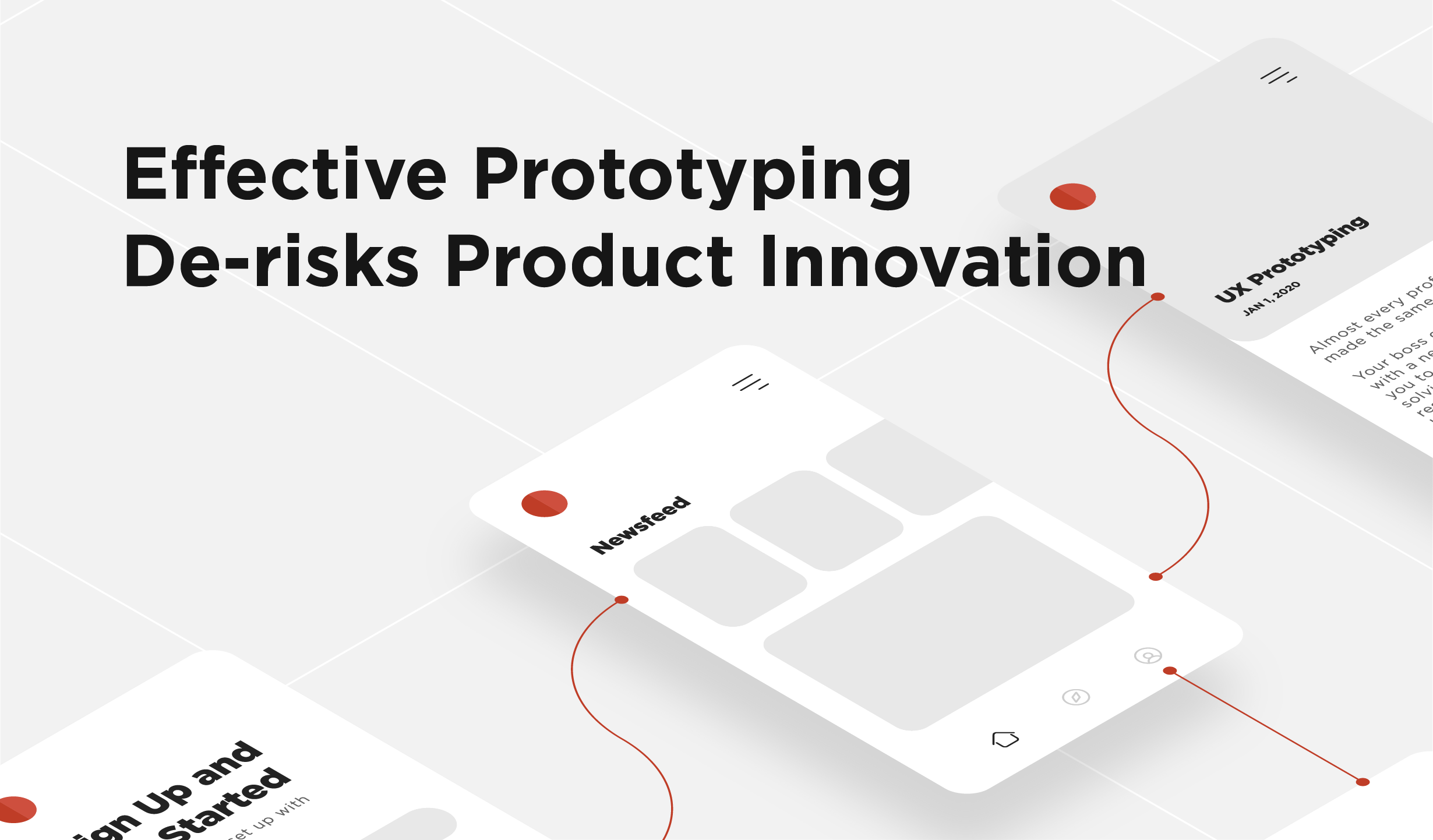Effective UX Prototyping De-risks Product Innovation

Product design and user experience work is fraught with tremendous amounts of risk because of the time, energy, and money that projects demand. Organizations are looking for ways to innovate faster, while mitigating the inherent risk in taking chances on new products and design. The balance between speed of innovation and risk isn’t new. What is new is the number (and size) of organizations embracing design thinking and prototyping as THE solution to de-risk product design.
Adopting the proper design thinking approach, along with a culture that embraces prototyping and rapid iteration, can improve time to market while reducing the capital and human costs of product development.
The Innovation Trap
Product teams are pressured to produce tools, software and products at a rapid pace, and are measured by how quickly they bring product iterations to market, or how well a new product is executed. The trap is focusing energy and attention on the execution, without creating infrastructure to test for market fit, or to ensure that a new product is accomplishing the business outcomes it’s meant to.
Oftentimes, an organization may target and measure for usability, or ease of use, or thoroughness of the style and the experience of a new idea, without validating that the new idea is the correct one. A concept may test well for usability, brand experience, and functionality, but it might not serve a need that the market desires. Simply put, a company can execute an idea well, but can fail to validate the need for the new product or innovation.
How do you avoid the trap?
1. Business outcomes should drive your prototyping hypotheses, just as much as usability and experience.
The best UX designers are trained to identify usability and experience gaps within their prototypes. They aren’t always adept at recognizing the market forces and business outcomes that a new product is solving for. A great product solves problems for its users, but should also provide tangible return for the business. When defining your prototyping process, be sure to include the ultimate business outcomes as part of your testing design.
2. Don’t forget the other tools in your design thinking toolbox.
Great product leaders, and great innovation designers have hundreds of different methodologies in their toolbox to draw from. The real art and skill is knowing when to use what tool. Some will take longer, but reduce more risk , while other approaches maybe quicker and given certain business contexts, may reduce a similar amount of risk.
Prototyping is becoming easier, and more popular, but knowing when to use which forms of prototyping is more important than simply knowing how to create any single prototype.
Consider the case of P&G’s Swiffer. P&G skipped many of its design thinking phases and jumped straight into the development of new soaps that would improve their customer’s floor cleaning experience. They assumed that users wanted new soaps, without stepping through a proper design thinking approach.
After a series of failures, they hired a design thinking firm, who leveraged direct interaction with customers to recognize that consumers didn’t want new soap, but actually wanted a new mop. P&G began testing different versions of disposable mops, eventually settling on the design of the Swiffer. A design thinking approach, backed with user research and eventually prototyping, created a half-billion dollar market where one didn’t exist before.
3. Recognize that your organization’s UX Maturity and culture may need to change.
Every organization possesses a certain level of UX Maturity and testing infrastructure, and this will affect the risk involved with product innovation. Knowing where your organization fits could provide clues as to the steps needed to adopt a prototyping culture.
The most mature companies are building prototyping and testing infrastructure; including employee facing interfaces, and testing and reporting tools - all in the interest of de-risking the process of innovation.
Consider Facebook, whose famous motto “Go Fast and Break Things” is rooted in the prototype-and-test methodology. Mark Zuckerberg recently explained that Facebook’s speed in the early days injected risk into their systems because they didn’t have the proper structure in place to execute.
Zuckerberg recognized early on that their innovation would be a function of their ability to test new UX and features in a stable environment. He said, “We thought, ‘OK, we need a new strategy to enable us to move fast.’ And what we came up with was: we’re going to do this by building the best infrastructure.
Today, “going fast” at Facebook is the result of a calculated approach to build a stable testing infrastructure, helping engineers speed up their prototyping. As the platform grew, “breaking things” became a much riskier and more costly for the company. Facebook slowed their new features builds for two years so they could get the proper structure in place. They are a more mature organization, with less risk involved in their testing processes.
Today, at any given time, there are more than 10,000 different live versions of Facebook, all being prototyped and tested by their engineers. Each version is testing user experience, levels of engagement, etc., and Facebook is able to ship the best-performing UX instantly.
4. When in doubt, rely on an expert
Most innovation leaders can recognize their need for additional UX prototyping assistance, but don’t have the time to change the entire culture of the organization. Hiring an outside expert (like P&G did with Swiffer) can be a cost-effective endeavor, especially if it helps jump-start your design thinking DNA.
The real risk in product development and improvement is not getting started.
If you’re looking for advice or help with UX prototyping, let’s chat. Whether you want to validate a concept, get buy-in, or take the first step toward making your idea come to life, we can help you navigate the process and uncover the insights you need to move forward.